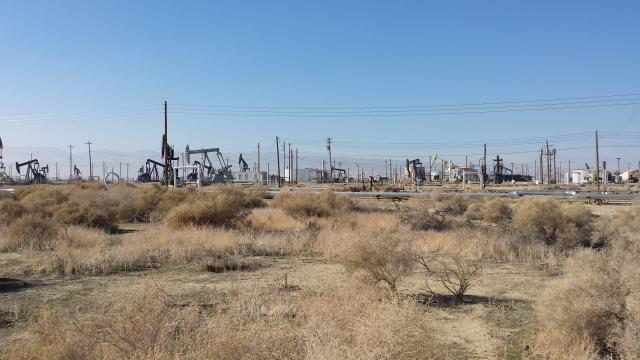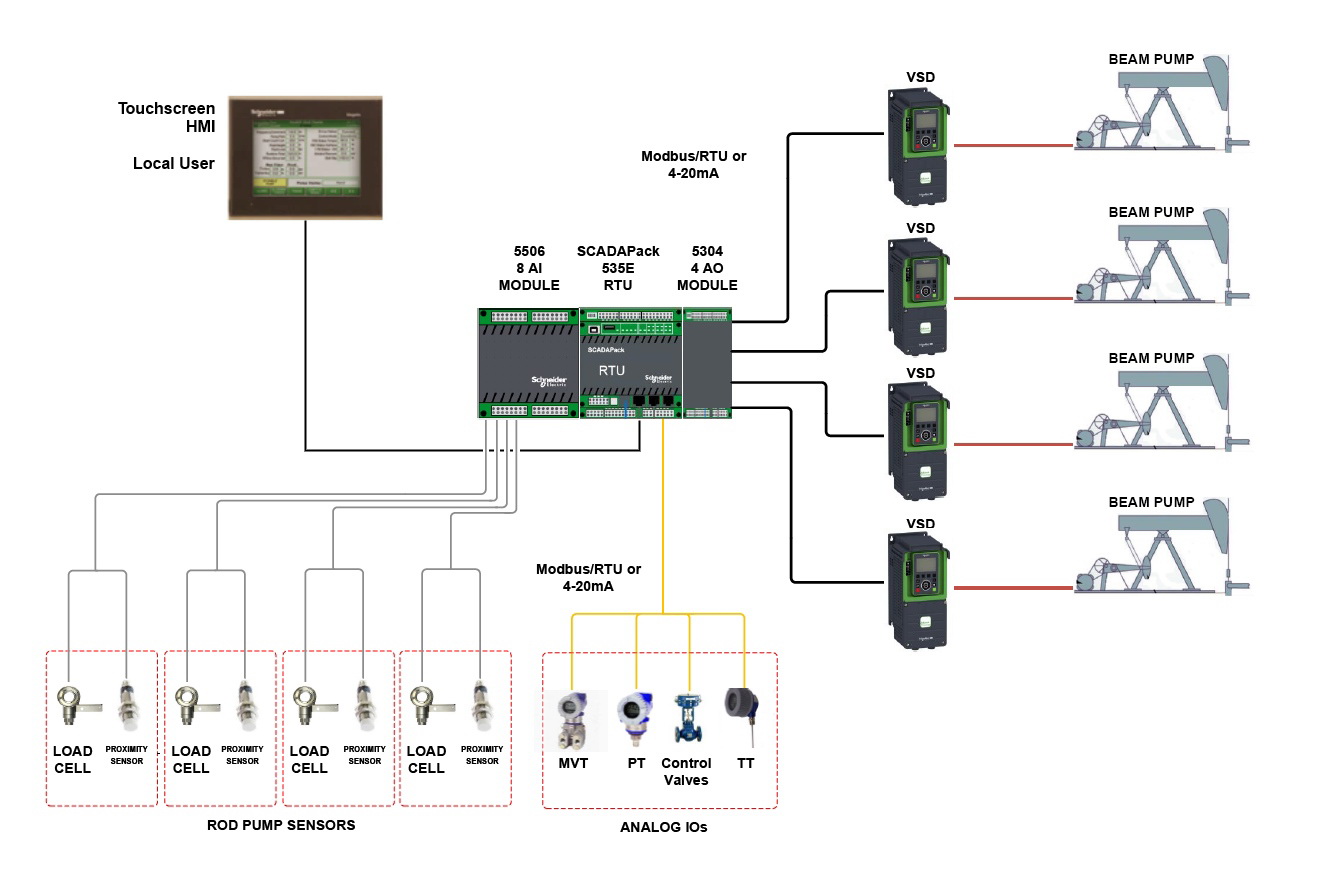
By combining technology capabilities of control systems with SCADA, numerous wells in a geographically dispersed infrastructure can be automated and monitored. (Source: Schneider Electric)
In less than two years the price of oil dropped from more than $145/bbl to $35/bbl, intensifying an effort from producers, manufacturers and operators to reduce operating costs across the oil and gas industry. The industry as a whole has shifted from focusing on production volume to being cash flow-driven. This means operators of mature oil fields globally were forced to make an organized effort to improve the overall efficiency of their operations to increase their chances for long-term success.
Though there are now signs of a rebound in the industry, external pressures such as smaller profit margins, increased regulations and a focus on energy efficiency have caused the oil and gas industry to put a much larger focus on becoming smarter with the use of digital technology and real-time data to make informed decisions quickly and accurately, maximizing productivity and reducing costs. These steps will last even if prices rebound.
Of particular importance to the efficiency of operations is the implementation of artificial lift automation solutions that provide operators with more visibility and control over operations. Instead of running pumps fulltime at a constant speed, companies can invest in realtime pump control to monitor downhole and surface conditions for multiple wells.
The influx of data required to manage wells means artificial lift automation has become more connected, and solution providers are offering holistic end-to-end solutions to operators, including information control, safety solutions and related maintenance services that allow companies to increase oil production, decrease power consumption and extend equipment life.
Smarter oil fields
To help reduce production costs and save revenue, oil producers are making much larger investments in the Industrial Internet of Things (IIoT). Data derived from the IIoT have the potential to provide useful insight when leveraged and analyzed effectively. To keep up with the amount of data generated and available to oil enterprises, automated artificial lift systems operate as a single hub for autonomous operation by maximizing performance through the utilization of real-time data on production to provide insight on subpar asset performance. Data, combined with advances in automation technology, allow operators to configure assets to specific operations to achieve better performance and business standards.
By providing a flexible and open automation platform for artificially lifted wells, upstream operators have the ability to comprehensively manage and control production wells and surface facilities, giving operators a single platform to work from and helping them control every asset of the enterprise to achieve real-time business control. Comprehensive artificial lift solutions are based on remote terminal unit (RTU) platforms that require a solid software backbone to monitor and manage the performance of wells in real time to optimize production, serving as a first step in creating smart oil fields.
Additionally, the newest solutions across the industry focus on combining a comprehensive hardware platform with a software backbone to create holistic solutions that reduce operating costs, increase production and improve the pump’s lifespan, helping operators meet critical production and maintenance key performance indicators.
For example, Schneider Electric’s artificial lift rod pump control Realift is in use in oil fields across the U.S. as well as locations worldwide such as Canada, Mexico, Venezuela, Colombia and others. It provides operators with all major automation components in a single solution, including variable speed drives, RTUs, SCADA, instrumentation, communications and human-machine interfaces, to reduce ownership risk and improve production efficiency. With a point-and-click configuration interface that runs via Ethernet, operators can leverage Realift to monitor and configure the drive and parameters locally or remotely in real time.
The rod pump control also allows operators to manage four rod pumps from a single RTU, reducing upfront equipment cost and minimizing the footprint at the wellhead. This is ideal for well pad applications where multiple wells are completed in close proximity. Another key advantage with the Realift technology is its inherent dual resource functionality, where each resource can be individually programmed for various applications.
By default, the first resource is used for artificial lift applications, whereas the second resource is open to operators for custom programming based on the International Electrotechnical Committee’s 61131 standard and can be used to run well test automation, flow measurement applications, tank level monitoring and more. So even if the artificial lift method on the wellhead changes, say from progressive cavity pumps to rod pumps, the program on the first resource could easily be transitioned to manage well-specific artificial lift methods. This allows the same hardware platform to be used over the production life cycle of the well.
The combined technology capabilities offered in Schneider Electric’s solution have been used to automate numerous wells with the company’s controllers and its ClearSCADA software offering for monitoring remote assets across geographically dispersed infrastructure. With real-time control and monitoring the technology can help increase average net oil production, decrease customer power consumption and extend the life of customer assets. The technology ties data management and control under one roof to track temperatures, pressures and other datapoints to make the entire oil field smarter, from the wellhead to enterprise level.

Enabling operation
While operators already have real-time capabilities on artificial lift wells, looking at single-source solutions that are IIoT-enabled promotes open communication between assets and ensures the entire oil enterprise is connected, reducing operating expenses, improving overall energy consumption and business performance and increasing the level of safety across the enterprise.
Because smart artificial lift automation platforms must work alongside other components of the smart oil field, the newest technology incorporates distributed network protocol (DNP3) to manage data starting from the source to track information from the wellhead to the enterprise level, making data management easier and more insightful. While DNP3 began on the electrical side and has been commonly adopted in that area, the proliferation of IIoT has enabled the automation industry to leverage the technology to more easily merge the management of electrical resources in the oil field from both generation and distribution under one protocol. Besides supporting multiple masters, DNP3 also offers an automated data back-filling capability, which allows data to be recovered automatically in case of communication loss.
Connected systems inherently present a cybersecurity risk. Currently, the drive among regulatory groups has started with electrical infrastructure, but the oil and gas industry is quickly realizing the importance of cybersecurity for upstream applications. While the industry as a whole is moving toward automation technologies that provide more robust and customizable solutions, it has not historically used the built-in cybersecurity capabilities provided on automation platforms. DNP3 open telemetry applications apply encryption when customers are using wireless or wired communications, which adds an added layer of cybersecurity capability to prevent breaches across the operation.
Comprehensive strategy
The shift to smarter, more comprehensive artificial lift automation is enabling the industry to make great strides in adopting a more comprehensive enterprise strategy. With all major components of artificial lift automation under one roof, smart solutions ensure reduced system downtime to decrease failures and improve production optimization. Built-in communication encourages more proactivity in terms of troubleshooting and locating problems before systems become disturbed. By giving operators more remote visibility into operations, safety can be improved by preventing well operators from physically traveling from well to well throughout the oil field.
While subsurface technologies have continued to advance steadily, artificial lift automation has historically lagged behind. The number of pad completions enabled by better directional drilling and fracturing has increased, which has dramatically reduced drilling and completion costs.
By using solutions that are IIoT-enabled, artificial lift solutions become the hubs for automation of wells or well pads, giving operators access to real-time monitoring and analytics capabilities. Realift controllers will allow the concentration of automation into a single platform, not only bringing new benefits to pad completions but providing the first step in realizing a comprehensive enterprise oil strategy.
Recommended Reading
Trump Says He Will Double Tariffs on Canadian Metals to 50%
2025-03-11 - President Trump said he would double his tariffs on Canadian steel and aluminum products in response to Ontario placing a 25% tariff on electricity supplied to the U.S.
E&P Highlights: March 10, 2025
2025-03-10 - Here’s a roundup of the latest E&P headlines, from a new discovery by Equinor to several new technology announcements.
Diversified, Partners to Supply Electricity to Data Centers
2025-03-10 - Diversified Energy Co., FuelCell Energy Inc. and TESIAC will create an acquisition and development company focused on delivering reliable, cost efficient net-zero power from natural gas and captured coal mine methane.
Ring May Drill—or Sell—Barnett, Devonian Assets in Eastern Permian
2025-03-07 - Ring Energy could look to drill—or sell—Barnett and Devonian horizontal locations on the eastern side of the Permian’s Central Basin Platform. Major E&Ps are testing and tinkering on Barnett well designs nearby.
US Drillers Cut Oil, Gas Rigs for First Time in Six Weeks
2025-03-07 - Baker Hughes said this week's decline puts the total rig count down 30, or 5% below this time last year.
Comments
Add new comment
This conversation is moderated according to Hart Energy community rules. Please read the rules before joining the discussion. If you’re experiencing any technical problems, please contact our customer care team.



